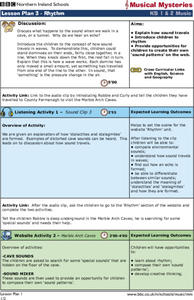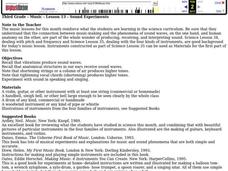Curated OER
Transformation of Energy- Sound
Sixth graders investigate how sound is made by vibrating matter. They work with a ruler and a rubber band to produce different types of vibration which makes different pitches of sound. They record their observations of the noises made...
Curated OER
Language Arts: Rhyming Words
Second graders discover words that rhyme and how to recognize them. After reading a book and singing a song, they identify the rhyming words in each. Students add their own rhyming words and complete a worksheet.
Curated OER
Manipulate Sound Waves
First graders use the scientific process to investigate sound in the classroom and at home. They participate in several hands-on activities exploring sound. They then are introduced to sound vocabulary such as muffled, sharp, and tinkling.
Curated OER
Adding Sound to a Story
Middle schoolers read a short story about the rain forest. They listen to a recording of rain forest sounds and break into several smaller groups to create a soundtrack to the rainforest story.
Curated OER
Sounds Good To Me - Instrument Creation
Third graders differentiate between pitch and volume and explain how sound travels through different materials. They analyze sound waves for their basic characteristics. Students design an instrument based on the principles of sound...
Curated OER
Objects Vibrate
Students strike a tuning fork and dip it in water. They sprinkle cereal flakes on a drum, than tap the top of the drum. Students stretch a rubber band between two fingers and pluck it; stretch the elastic farther and pluck it again. Then...
Curated OER
Changing Sounds
Students identify how the pitch of an instrument can be altered. They complete a worksheet by labeling several images in order of pitch and then fill a bottle with water to create a sound that matches a pitch on a drawn card.
Curated OER
Ride the Wave!
Students examine how sonar works. They discuss the concept of sound waves, observe a demonstration of how sonar works using water, pie plates, and eyedroppers, and describe how sonar works in their own words.
Curated OER
Sounds Great
Students examine the types of sounds sculptures make. They create their own sculpture that make sound using everyday materials.
Curated OER
Our Five Senses Box
Students discuss how their five senses help to identify objects. They select items from a mystery box and with their eyes closed they attempt to identify the object. They give answers in complete sentences.
Curated OER
Bravo!!
Second graders study and experiment with rhythm and sound. In pairs, they practice reading and performing simple melodies from sheet music. Individually, they choose one piece to perform for the class.
Curated OER
Musical Mysteries
Students examine the changes that occur to sound as the pressure changes. Echoes and sound changes in caves and tunnels are explored in this instructional activity.
Curated OER
Sounds Like Science - Bottle Organ
Students see that by manipulating sound we can arrange a series of notes referred to as a musical scale. They explain the relationship between pitches and notes. They compare the sounds of different-sized bottles.
Curated OER
Sounds Like Science - Guitars
Students discover that all movement produces sound waves but not all sounds can be heard with the human ear. They experiment with a variety of substances to see which are audible and which are inaudible.
Curated OER
Sounds Like Science - Jamboree
Pupils create a delightful-sounding ensemble. They explore the subjective distinctions between noise and music. They use jars, buckets, boxes, strings, rackets, frames, string, rubber bands and bottles to make their own jamboree.
Curated OER
Sounds Like Science - Kazoo
Learners discover that energy is needed to produce sound. They see that identifying where the energy comes from enables us to control the type of sound produced. They play the kazoo and manipulate the sound in a variety of ways.
Curated OER
The Power of Line Break; The Power of Perspective
Twelfth graders read the poem "Man and Wife" and then write their own poem that uses two perspectives.
Curated OER
Understanding Waves
Students perform 3 hands-on activities to help them explain the terms "crest" and "trough" as related to sound, water, and light waves. All three waves types have troughs and crests. The activities use toys to demonstrate the properties...
Curated OER
Sounds You See, Hear, and Feel
Middle schoolers explore and create sound wave vibrations using musical instruments and common objects. They compare/contrast and describe actions that cause sound wave vibrations that can be seen, heard, and felt.
Curated OER
Music
Third graders study sound waves and vibrations. They sing a silly round in three parts.
Curated OER
Sound - Lesson Plan
Tenth graders should know how sound is produced and state some properties of sound.
Curated OER
Sound and Hearing - Internet Research
Students use a website to help them recognize that sound is generated in a variety of ways and from different sources. They determine that sounds vary in tone and loudness, and learn there are different ways to describe sound.
Curated OER
Changing Sounds
Students identify how the pitch and the loudness of an instrument can be altered by examining the sounds made by three instruments.

























